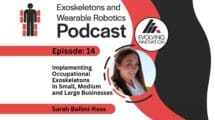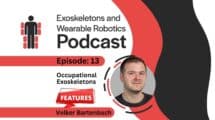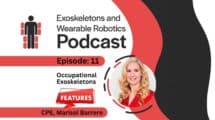At WearRAcon16 I had the opportunity to personally try out the Laevo, a new European back support exoskeleton for workers in all types of industries. The name Laevo comes from the Latin word ‘Levo’ which means enlighten, floating and reducing. After donning the device I think that the name suits it well. This exoskeleton is enlightened by being task specific. The problem of lower back pain comes first, and several iterations of the Laevo address it. The device is both reduced and reducing. This is a passive exoskeleton; it has no motors or electronics. While bending forward, the Laevo transfers some of the force using straps or harder materials, depending on the version, into gas springs and then into the thigh. This reduces the activation of the back muscles while bending forward. A preliminary study has shown a 40% reduction in the activation of the back muscles while wearing the Laevo. The study monitored the activation of the two major lower back muscles (the Erector Spinae Iliocostalis and Erector Spinae Longissimus) using Electromyography (EMG).
Highlights of the Laevo with soft straps:
- Very light and comfortable to wear, at least for short durations.
- Very easy to put on and remove.
- Provides a sensation of an upward push in the chest and a downward push in the legs while leaning forward.
- The back feels significantly more relaxed while leaning forward.
- The gas spring deactivates* during kneeling, crouching or sitting position.
- Straps’ length can be adjusted in both the vertical and horizontal directions for a custom fit.
Negatives:
- Walking is slightly hindered.
- The version presented has issues fitting on women.
Development Goals:
Laevo began as part of the X-arm project, carried out by InteSpring B.V. and Delft University of Technology from 2010 through 2013. Originally designed to assist nurses with lifting patients, it became apparent that the exoskeleton can be applied to multiple other work environments. It is designed for workers that have to repeat repetitive bending motions, for people with back pain or those at risk of suffering from back pain. Back pain is currently the biggest burden in industry. It affects employees in factories, construction workers, nurses and farmers amongst many others. Back pain costs employers lost work hours, medical bills, lower quality of work due to pain and fatigue and legal fees. Employers that can’t afford mistakes on large projects, such as aircraft companies, can’t afford to lose skilled labor and can benefit from using exoskeletons for industrial use.
Laevo likes to think of its devices not as a complicated machine but as a bicycle. Something simple that helps a person go further. Laevo has two pending patents on its technology. The soft Laevo is so unrestrictive that a person can walk on a tightrope with it. Current testing shows an 80% acceptance rate where the customer would use it on a daily basis. The current price is $2000 but that can be brought down if it is produced in larger volumes. This price tag puts the Laevo at 2.5 times more expensive than the V22 but still 10 times lower than a tool holding exoskeleton such as Ekso Works or FORTIS. The company projects that the device would pay for itself after one year of use.
A second version:

Another version of the Laevo that is featured on the company’s website replaces the front straps with a harder material that connects the gas springs at the hips to the chest plate at the front. Just like the soft straps Laevo, this version reduces the strain on the back muscles while bending forward. However, the hard frame also allows for some of the forces generated in the body while bending forward to completely bypass the spine and go directly into the legs. The tradeoff of this model is that it is much harder to walk with it. Here is how the Laevo team describes this:
When bent forward, for example to look at something, a lot of people will support themselves by placing their hands on their upper legs for support. This allows part of the load to be transferred through the arms, unto the legs. This is a natural way to relieve the stress on the back muscles and makes it easier to maintain a bend forward posture.

The Laevo does exactly the same: when bent forward, part of the upper body weight rests on the chest pads of the Laevo, this load is then transferred through the framework, unto the upper legs. Meanwhile you retain your freedom of movement, because the Laevo will move with you. – Laevo General Information Brochure, March 2015 (link to pdf)
Ideally, the Laevo team will build an intermediate model that allows for people to walk but also reduces compression on the spine. Another possibility would be for a spring disengage switch, similar to the one found on the Ski Mojo. Alternatively, the two versions can be marketed separately based on the worker’s needs. Those that want comfort and muscle relief can use the soft Laevo as featured in the above video, and people with prior back injury that can sacrifice a little mobility at their job place can use the one with hard front connections.
Similar Devices:
The Laevo is a back support passive exoskeleton for work and industrial use. There are currently two similar exoskeleton devices. One is the V22 by StrongArm Technologies. The V22 ergo skeleton ™ keeps the spine aligned during lifting and has a clutch rope mechanism that transfers weight from the arms to a harness where the force gets distributed evenly. Another similar device is the Trunk Support Exoskeleton which is a module of the Modular Agile eXoskeleton (MAX) by SuitX (formerly US Bionics).
The Laevo and V22 do two different things. One provides support to the back by reducing the activation of the back muscles while the other maintains proper posture and distributes the loads from the arms more evenly along the back. Both are pioneers in the exoskeleton market for back support during lifting. As a side note, it would be interesting if a V22 which specializes in the forces in the upper part of the spine can be combined with a Laevo. This way part of the load of a heavy box that needs to be lifted could travel directly into the thighs during the lift. Reportedly, pick and carry accounts for 70% of all industrial work.
Further reading:
Please visit the Laevo website which has a lot more information. Note that the website is in several languages but the language controls a bit tricky to find.
The Laevo was demoed during the first Wearable Robotics Association Conference, WearRAcon16. You can find a report of all three days of the conference here: Day 1, Day 2 and Day 3.
You can also find more about the V22 at the StrongArm Tech website.
Note:
* A fan of ExR on Twitter who has also tried on the Laevo has pointed out that the gas springs never “deactivate” but always stay on. The force the Laevo provides changes depending on the where the user is in the stooping motion. The force increases as the user bends forward and then tapers off.








Add Comment